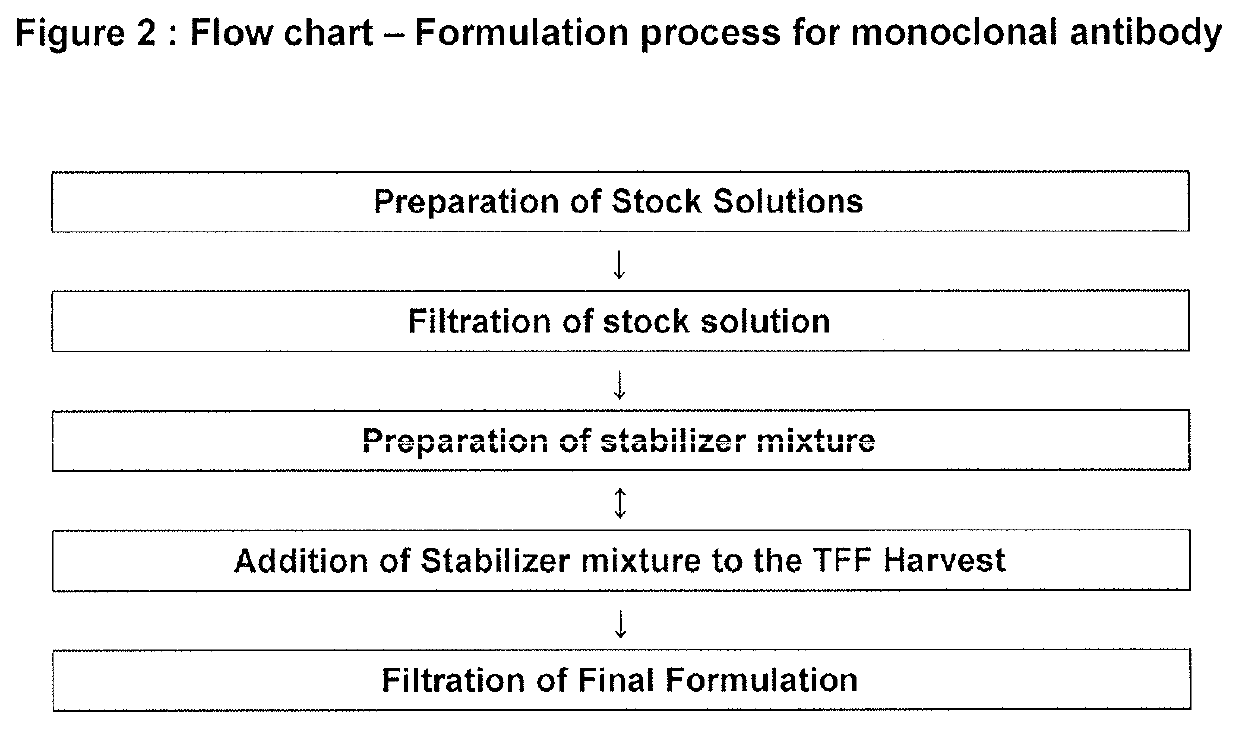Improved methods for enhancing antibody productivity in mammalian cell culture and minimizing aggregation during downstream, formulation processes and stable antibody formulations obtained thereof
a technology of mammalian cell culture and aggregation, which is applied in the direction of antibody medical ingredients, inorganic non-active ingredients, drug compositions, etc., can solve the problems of no antiviral agents, recent vaccine trials have fallen short of expectations, and formulation development can often be the rate-limiting step, etc., to achieve the effect of reducing the viscosity of highly concentrated antibody solutions and high potency and stability
- Summary
- Abstract
- Description
- Claims
- Application Information
AI Technical Summary
Benefits of technology
Problems solved by technology
Method used
Image
Examples
example 1
Process for Cell Culturing and Expression of Therapeutic Protein i.e. Dengue (VIS513) Monoclonal Antibody
[0091]Protocol:
[0092]Cell culturing at 10 L scale was carried out in a Fed batch manner using below mentioned parameters during fermentation / upstream process.
[0093]The Dengue monoclonal antibody was expressed in cell line “CHO-K1 SV GS-KO” obtained from Visterra Inc. USA.[0094]Cell culture medium used for cell growth and expression of therapeutic protein i.e. Dengue monoclonal antibody was 1× Celivento™ CHO-220 Liquid Medium.[0095]Feed solution A, Feed solution B, Feed solution C, Feed solution D selected from group comprising of Glucose, Cell Boost™ 5 Supplement (Hyclone), EX-CELL 293 (Sigma Aldrich), Cell Boost 7a and 7b supplements (Hyclone), 3× Actipro (Hyclone), Cell Vento 220 (3× medium), EX-CELL® Advanced™ CHO Feed 1 was used for supplementation feed.[0096]pH of the fermentation medium was maintained at 6.7 to 7.5.[0097]Osmolality of the fermentation medium was maintained ...
example 2
[0105]Cell culture obtained in Example 1 was harvested and later subjected to protocol for purification of the dengue (VIS513) monoclonal antibody as per FIG. 1
[0106]Detailed process used was as follows:[0107]Protein-A Affinity Chromatography:[0108]In this step targeted monoclonal antibody was separated from the media components in the harvested supernatant. Clarified supernatant was passed through the chromatography column and then eluted using compatible elution buffers.[0109]Materials used:[0110]Resin (Matrix): Mab Select Sure / Eshmuno A (Protein-A Affinity)[0111]Residence Time: 4.0-8.0 minutes[0112]Column used: XK 26[0113]Equilibration Buffer: 20 mM Phosphate Buffer+150 mM NaCl+0.05% (w / v) Polysorbate 80, pH 7.0±0.2.[0114]Wash I Buffer: 20 mM Phosphate Buffer+150 mM NaCl+0.05% (w / v) Polysorbate 80, pH 7.0±0.2.[0115]Wash II Buffer: 20 mM Phosphate Buffer+1M NaCl+0.05% (w / v) Polysorbate 80, pH 7.0±0.2.[0116]Wash III Buffer: 10 mM Phosphate Buffer+125 mM NaCl+0.025% (w / v) Polysorbat...
example 3
[0168]Purified Dengue (VIS513) monoclonal antibody was formulated as follows:
[0169]Excipients i.e. Arginine, Histidine, NaCl, Sucrose, and polysorbate-80 were added and mixed thoroughly using a magnetic stirrer at 50-60 RPM to form a mixture of excipients. This mixture was then added into the Dengue mAb TFF harvest gradually with stirring rate 50-60 RPM. pH was checked (pH 6.5) and if required adjusted by histidine-arginine buffer. The final formulation was filtered through a 0.2 μM filter and filled into final container.
[0170]The concentration of each component in the final formulation was as follows:
TABLE 11IngredientFormulation 1Formulation 2Formulation 3Dengue Mab (VIS513)10mg / ml25mg / ml50mg / mlHistidine25mM25mM25mMArginine75mM75mM75mMSodium Chloride101mM101mM101mMSucrose0.5%w / v0.5%w / v0.5%w / vPolysorbate-800.02%w / v0.02%w / v0.02%w / vpH6.5 + 0.56.5 + 0.56.5 + 0.5Osmolality380mOsm / kg380mOsm / kg380mOsm / kg
[0171]These formulations were further tested for purity, stability, efficacy and pote...
PUM
| Property | Measurement | Unit |
|---|---|---|
| Temperature | aaaaa | aaaaa |
| Fraction | aaaaa | aaaaa |
| Fraction | aaaaa | aaaaa |
Abstract
Description
Claims
Application Information
 Login to View More
Login to View More - R&D
- Intellectual Property
- Life Sciences
- Materials
- Tech Scout
- Unparalleled Data Quality
- Higher Quality Content
- 60% Fewer Hallucinations
Browse by: Latest US Patents, China's latest patents, Technical Efficacy Thesaurus, Application Domain, Technology Topic, Popular Technical Reports.
© 2025 PatSnap. All rights reserved.Legal|Privacy policy|Modern Slavery Act Transparency Statement|Sitemap|About US| Contact US: help@patsnap.com


